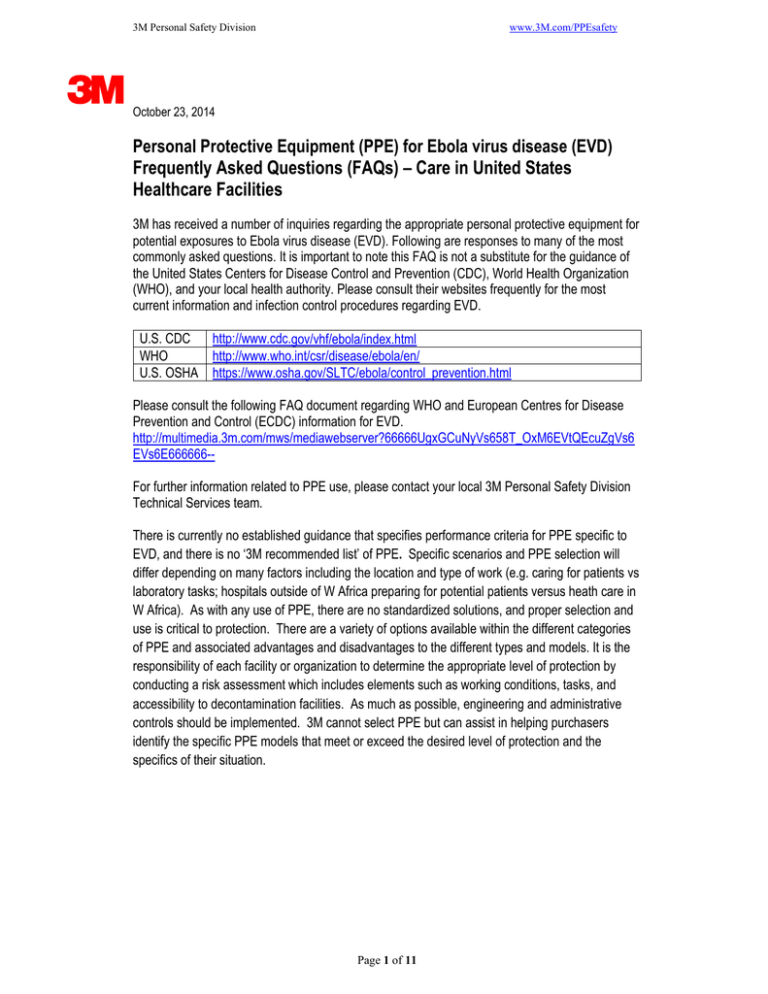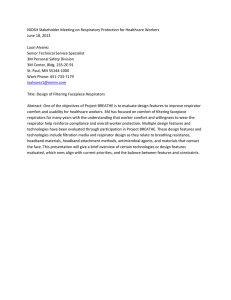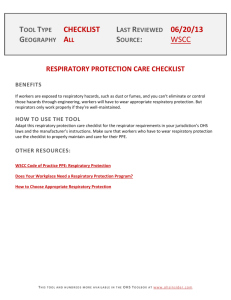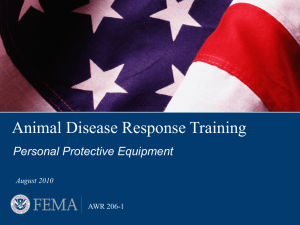3 Frequently Asked Questions (FAQs) – Care in United States Healthcare Facilities
advertisement

3M Personal Safety Division
www.3M.com/PPEsafety
3
October 23, 2014
Personal Protective Equipment (PPE) for Ebola virus disease (EVD)
Frequently Asked Questions (FAQs) – Care in United States
Healthcare Facilities
3M has received a number of inquiries regarding the appropriate personal protective equipment for
potential exposures to Ebola virus disease (EVD). Following are responses to many of the most
commonly asked questions. It is important to note this FAQ is not a substitute for the guidance of
the United States Centers for Disease Control and Prevention (CDC), World Health Organization
(WHO), and your local health authority. Please consult their websites frequently for the most
current information and infection control procedures regarding EVD.
U.S. CDC
WHO
U.S. OSHA
http://www.cdc.gov/vhf/ebola/index.html
http://www.who.int/csr/disease/ebola/en/
https://www.osha.gov/SLTC/ebola/control_prevention.html
Please consult the following FAQ document regarding WHO and European Centres for Disease
Prevention and Control (ECDC) information for EVD.
http://multimedia.3m.com/mws/mediawebserver?66666UgxGCuNyVs658T_OxM6EVtQEcuZgVs6
EVs6E666666-For further information related to PPE use, please contact your local 3M Personal Safety Division
Technical Services team.
There is currently no established guidance that specifies performance criteria for PPE specific to
EVD, and there is no ‘3M recommended list’ of PPE. Specific scenarios and PPE selection will
differ depending on many factors including the location and type of work (e.g. caring for patients vs
laboratory tasks; hospitals outside of W Africa preparing for potential patients versus heath care in
W Africa). As with any use of PPE, there are no standardized solutions, and proper selection and
use is critical to protection. There are a variety of options available within the different categories
of PPE and associated advantages and disadvantages to the different types and models. It is the
responsibility of each facility or organization to determine the appropriate level of protection by
conducting a risk assessment which includes elements such as working conditions, tasks, and
accessibility to decontamination facilities. As much as possible, engineering and administrative
controls should be implemented. 3M cannot select PPE but can assist in helping purchasers
identify the specific PPE models that meet or exceed the desired level of protection and the
specifics of their situation.
Page 1 of 11
What is Ebola virus disease (EVD)?
Ebola virus disease (also known as Ebola hemorrhagic fever) is a severe, often-fatal disease
caused by infection with a species of Ebola virus. EVD is a severe acute viral illness often
characterized by the sudden onset of fever, intense weakness, muscle pain, headache and sore
throat. This is followed by vomiting, diarrhoea, rash, impaired kidney and liver function, and in
some cases, both internal and external bleeding.
Outbreaks of Ebola outbreaks have occurred sporadically in parts of Africa, South America, the
Middle East and Eastern Europe. It is a severe, often fatal disease in humans with fatality rates
ranging up to 90%.
How is it transmitted?
Ebola is spread through direct contact with blood or body fluids (including, but not limited to urine,
saliva, sweat, feces, vomit, breast milk and semen) of an infected person or animal, or through
contact with objects that have been contaminated with the blood or other body fluids of an infected
person, dead or alive. Transmission is believed to occur via contact with mucous membranes and
non-intact skin (i.e., rashes, cuts, etc.). Risk of infection by inhalation of contaminated aerosols by
healthcare workers has not been documented, but thought by health authorities to be low at this
time based on case history evidence.
Ebola virus is readily killed by soap, bleach, direct sunlight, or drying. Machine washing clothes
that have been contaminated with fluids will destroy Ebola virus. Ebola virus survives only a short
time on surfaces that are in the sun or have dried.1
What does the US Centers for Disease Control and Prevention recommend for personal
protection equipment (PPE) to be used by health care workers against Ebola virus disease?
The prevention of Ebola virus infection depends on avoiding contact with blood and body fluids of
infected individuals and with objects contaminated with these fluids. Barrier precautions are used
to prevent skin or mucous membrane exposure of the eyes, nose, and mouth with blood, other
body fluids, secretions (including respiratory droplets), or excretions.
On October 20, 2014 the US CDC published “Guidance on Personal Protective Equipment To Be
Used by Healthcare Workers During Management of Patients with Ebola Virus Disease in U.S.
Hospitals, Including Procedures for Putting On (Donning) and Removing (Doffing)”
http://www.cdc.gov/vhf/ebola/hcp/procedures-for-ppe.html
The CDC document includes guidance on administrative and environmental controls; PPE
selection, donning and doffing; training; and use of a trained observer. It is important that anyone
involved in infection control for ebola virus disease (EVD) thoroughly read and understand
this document.
Page 2 of 11
The following is a short summary of the CDC recommended PPE.
Health care workers during management of Ebola patients
Powered air purifying respirator (PAPR) with full facepiece, helmet, or hood; or N95
respirator. Any reusable PAPR headgear must be covered with a single-use (disposable)
hood that extends to the shoulders, fully covers the neck and is compatible with the PAPR.
{Note: For simplicity, users may likely prefer using disposable PAPR hoods instead of
covering full facepiece and helmets with accessory disposable hoods.} Disposable N95
respirators must be used with a single-use (disposable) surgical hood and a single use
(disposable) full face shield. CDC notes that a face shield may not provide full face
protection in the setting of significant splashing.
Single-use (disposable) fluid-resistant or impermeable gown that extends to at least midcalf or coverall without integrated hood. Coveralls with or without integrated socks are
acceptable. “If gowns or coveralls with thumb hooks are not available, personnel may
consider taping the sleeve of the gown or coverall over the inner glove to prevent potential
skin exposure from separation between sleeve and inner glove during activity.”
Two pairs of single-use (disposable) nitrile examination gloves with extended cuffs.
Single-use (disposable) fluid-resistant or impermeable boot or shoe covers.
Single-use (disposable), fluid-resistant or impermeable apron that covers the torso to the
level of the mid-calf if patients have vomiting or diarrhea.
Trained observers during PPE doffing
Single-use (disposable) fluid-resistant or impermeable gown that extends to at least midcalf or coverall without integrated hood.
Single-use (disposable) full face shield.
Two pairs of single-use (disposable) nitrile examination gloves with extended cuffs.
Single-use (disposable) fluid-resistant or impermeable shoe covers.
The CDC recommends that if facilities elect to use different PPE from what is outlined in their
guidance, such as coveralls with an integrated hood, they must train workers in use and adjust the
donning and doffing procedures.
The CDC emphasizes hand hygiene and instructs that hand hygiene be performed thoroughly and
often including before and after donning and before and after doffing.
Please see appendices 1-3 for examples of 3M goggles, face shields, coveralls and respirators.
What is eye protection, protective clothing and respiratory protection?
There are several different types of PPE in their guidance documents.
Eye Protection
Eye protection provides a barrier to infectious materials from entering the eye and is often used in
conjunction with other personal protective equipment (PPE) such as gloves, gowns, and masks or
respirators. See Appendix 1.
Goggles
Goggles are designed to fit snugly, but not necessarily seal around the wearer’s eyes. NIOSH
states2: “appropriately fitted, indirectly-vented goggles* with a manufacturer’s anti-fog coating
provide the most reliable practical eye protection from splashes, sprays, and respiratory droplets.
Page 3 of 11
However, to be efficacious, goggles must fit snugly, particularly from the corners of the eye across
the brow. While highly effective as eye protection, goggles do not provide splash or spray
protection for other parts of the face.”
* Directly-vented goggles may allow penetration by splashes or sprays; therefore, indirectly-vented
or non-vented goggles are preferred for infection control.
Face Shields
Face shields are designed to help protect portions of the wearer’s face to certain exposures. For
certain tasks a worker may choose to wear a face shield in addition to goggles for infection control.
While goggles help protect a wearer’s eyes from splashes, sprays, and droplets, a face shield can
help reduce exposure to the eyes and provide protection to other facial areas. Face shields should
have crown and chin protection and wrap around the face to the point of the ear. This will help
reduce the possibility of splash, sprays and droplets from going around the edges of the shield and
reaching the eyes or other facial areas.
Safety Glasses
Safety glasses provide impact protection but do not provide the same level of splash or droplet
protection as goggles and generally should not be used for infection control purposes.
For more information consult 3M Tech Data Bulletin #192 – Eye Protection for Infection Control:
http://multimedia.3m.com/mws/mediawebserver?mwsId=66666UF6EVsSyXTtNxMa5XfEEVtQEVs
6EVs6EVs6E666666-Protective Clothing
Currently there is no established guidance that specifies detailed performance criteria for
protective clothing (coveralls, gloves, foot coverings, etc.) specific to EVD. Until such guidance is
published, selection of personal protection ensembles should be based on a site-specific PPE
hazard assessment. Performance criteria included in EN 14126:2006 - Performance
Requirements and Test Methods for Protective Clothing Against Infective Agents should be
considered. See Appendix 2. In general, protective clothing offering the highest level of protection
from infective agents tends to be the least breathable and may introduce hazards related to heat
stress and dehydration.
Breathable protective clothing offers less protection but may be desired for tasks in extremely hot
conditions where the risk of contacting infective agents is low, where sufficient decontamination
facilities are available at the completion of work tasks, and where the risk of harm from heat stress
and dehydration is high.
Selection for EVD should be based primarily on the potential exposures and need for protection
against infective fluids and agents. However work conditions, environmental conditions, tasks and
accessibility to decontamination facilities should be considered.
Respiratory Protection
Another type of PPE recommended for those in contact with potential EVD cases. This section
discusses the use of respiratory protection.
For more information on the differences between surgical masks and respirators please consult
3M Technical Data Bulletin #231 - Respirators and Surgical Masks: A Comparison.
http://multimedia.3m.com/mws/mediawebserver?SSSSSuH8gc7nZvTSP8_1oxmSevUqe17zHvTS
evTSeSSSSSS-A respirator is a device designed to help provide the wearer with respiratory protection against
inhalation of a hazardous atmosphere.
Page 4 of 11
To help reduce nose, mouth and respiratory system exposures to particles that are potentially
airborne (< 100 microns), particulate filtering respirators are often recommended. Particulate
respirators are available as:
1. A filtering half facepiece respirator, where the filter is the entire respirator
2. An elastomeric (reusable) half mask with a particulate filter
3. An elastomeric (reusable) full facemask with a particulate filter
4. A powered air purifying respirator (PAPR) that includes a particulate filter
5. A supplied air respirator.
Particulate respirators are designed to help reduce the wearer’s exposure to certain airborne
particles. Currently, health authorities have not documented EVD as being transmitted from
infected individuals via airborne Ebola virus. However, droplets containing the Ebola virus that
have become aerosolized (e.g. from coughing, sneezing, vomiting, medical procedures, and
surfaces etc.) may have the potential to come into contact with a person’s mucous membranes in
their nose or mouth or non-intact skin. Therefore, respiratory protection may be helpful in
providing a barrier to help prevent infectious materials from contacting a wearer’s mucous
membranes. They may also help limit inadvertent touching of the nose, mouth and/or eyes (if a
full-facepiece or powered-air respirator is used). Respiratory protection is recommended for
workers performing certain tasks such as aerosol generating procedures, laboratory procedures
and autopsies. Many agencies are reportedly using respiratory protection for basic patient care.
See Appendix 3 for examples of different types of respirators.
For more information consult 3M Tech Data Bulletin #174 – Respiratory Protection for Airborne
Exposures to Biohazards
http://multimedia.3m.com/mws/mediawebserver?mwsId=66666UF6EVsSyXTtmXT25XTXEVtQEVs
6EVs6EVs6E666666-For aerosol generating tasks, laboratory procedures and autopsies a respirator is recommended
by health authorities. A control banding approach has been suggested for choosing between
different levels of respiratory protection based on the organism, generation rate, level of control
and respirator protection factor. http://www.cidrap.umn.edu/newsperspective/2014/09/commentary-health-workers-need-optimal-respiratory-protection-ebola
What are the advantages and disadvantages of different types of respirators?
Following are some general advantages and disadvantages of different types of respirators.
Disposable filtering facepiece respirator
Disposable, no maintenance
Lightweight
Less expensive
Need separate eye and face protection
Fit testing is required to ensure respiratory protection
Reusable half mask or full facepiece respirator
Often available in multiple sizes
Face pieces can be disinfected and reused
Full face pieces may provide eye and face protection
Fit testing is required to ensure respiratory protection
Face pieces must be maintained
Page 5 of 11
Powered air purifying (PAPR) respirator
Some elements can be disinfected and reused
Potential for higher level of respiratory protection
Less prone to fogging
Improved voice communication and patient rapport
No fit testing required for systems with loose fitting head covers
May not need separate eye and face protection depending on the head covering
Batteries need to be charged and entire unit maintained
Higher initial cost
Supplied air respirators
Some systems provide cooled air to the wearer
Potential for higher levels of respiratory protection
Can be disinfected and reused
No fit testing required for systems with loose fitting head covers
May not need separate eye and face protection depending on the head covering
Need adequate supply and pressure of compressed breathable air
Unit needs to be maintained
Higher initial cost
Please see the following link for guidelines for cleaning and disinfecting 3M™ Reusable Respirators
(RR) and Powered Air Purifying Respirator (PAPR) Assemblies following potential exposure to the
Ebola virus.
http://multimedia.3m.com/mws/mediawebserver?mwsId=SSSSSuH8gc7nZxtUPYten8_BevUqe17z
HvTSevTSeSSSSSS--&fn=RR%20and%20PAPR%20cleaning%20Ebola%20appro
Summary
Health authorities recommend that those who will be exposed to individuals with known or
suspected cases of EVD should wear PPE that provides a barrier to help prevent infectious
material from contacting mucous membranes (mouth, nose, eyes) and non-intact skin (i.e., rashes,
cuts, etc.). Respiratory protection should be utilized if there is a risk of aerosolized particles (i.e.
aerosol generating procedures, certain laboratory tasks, autopsies), or according to local health
authorities. Always ensure that PPE users are properly trained in the benefits and limitations of
the equipment per all applicable guidance and regulations and the manufacturer’s user
instructions. Please consult your occupational safety and health professional, the appropriate
health authority and the PPE manufacturer with questions.
References
1)
ECDC http://www.ecdc.europa.eu/en/healthtopics/ebola_marburg_fevers/informationtravellers/Pages/information-travellers.aspx
2) National Institute for Occupational Safety and Health (NIOSH). Eye Protection for Infection Control. September
2004. http://www.cdc.gov/niosh/topics/eye/eye-infectious.html
3) US CDC http://www.cdc.gov/vhf/ebola/index.html
4) WHO http://who.int/mediacentre/factsheets/fs103/en/
5) WHO “Interim Infection Prevention and Control Guidance for Care of Patients with Suspected or Confirmed
Filovirus Haemorrhagic Fever in Health-Care Settings, with Focus on Ebola.”
http://www.who.int/csr/resources/publications/ebola/filovirus_infection_control/en/
6) US CDC “Infection Prevention and Control Recommendations for Hospitalized Patients with Known or Suspected
Ebola Hemorrhagic Fever in U.S. Hospitals.” http://www.cdc.gov/vhf/ebola/hcp/infection-prevention-and-controlrecommendations.html
7) “Health workers need optimal respiratory protection for Ebola” Lisa Brosseau, Rachael Jones.
Center for Infectious Disease Research and Policy Sept. 7, 2014. http://www.cidrap.umn.edu/newsperspective/2014/09/commentary-health-workers-need-optimal-respiratory-protection-ebola
Page 6 of 11
Appendix 1 - Examples of 3M Protective Eyewear
Goggles
Product
Description
1664400000-10
(medium)
3M™ Lexa™
Splash
GoggleGear
™ AS/AF
(medium)
(anti-scratch/antifog)
Eye Protection
(Splashes,
sprays, and respiratory droplets)
Face Protection
(Splashes, sprays, and
respiratory droplets)
Face Shields
16645-00000-10
(large)
40671-00000-10
82501-00000 and 82582-00000
3M™ Lexa™ Splash
GoggleGear™
AS/AF
(large)
3M™ Maxim™ Splash Goggle
Over-the-Glass (OTG) AS/AF
3M™ Ratchet Headgear H8A
with
3M™ Clear Polycarbonate
Faceshield WP96X
Yes
Yes
Yes
No
No
Yes
(anti-scratch/anti-fog)
(anti-scratch/anti-fog)
Page 7 of 11
Appendix 2 - Examples of 3M Protective Apparel
Important: These products will not eliminate the risk of infection. Currently there is no established guidance specifying performance criteria for protective clothing
specific to EVD. This information is presented to help safety professionals make informed decisions as part of a site and task specific PPE hazard assessment.
3M™ Protective
Coverall 4565
3M™ Protective
Coverall 4545
3M™Protective
Coverall 4540+
3M™ Protective
Coverall 4535
3M™ Protective
Coverall 4510
3M™ Overboot
440 / 450
3M™ Overhood
446
PPE Directive Approval
CE Category 3
CE Category 3
CE Category 3
CE Category 3
CE Category 3
N/A
N/A
Fabric type
Non-Breathable
Laminate
Micro-porous
Laminate
SMMMS / Microporous Laminate
Hybrid
SMMMS / Microporous Laminate
Hybrid
Micro-porous
Laminate
Micro-porous
Laminate
Micro-porous
Laminate
N/A
Product Image
General Data
Test Method
Suit Type
ISO 16602:2007
Type 4
Type 5/6
Type 5/6
Type 5/6
Type 5/6
N/A
Hood / collar options
-
Hood only
Hood only
Hood or collar
Hood only
Hood or collar
N/A
N/A
Seam construction
-
Serged & Taped
Serged and bound
Serged
Serged
Serged
Serged
Serged
N/A
Material Data per EN 14325
Abrasion resistance Method 2
EN530:1994
1/6
1/6
1/6
1/6
1/6
N/A
Flex Cracking Resistance, Method B
ISO 7854
1/6
3/6
4/6
5/6
5/6
N/A
N/A
Trapezoidal tear resistance
EN ISO 9073-4:1997
1/6
1/6
1/6
1/6
1/6
N/A
N/A
Tensile strength
EN ISO 13934-1:1999
1/6
1/6
1/6
1/6
1/6
N/A
N/A
Puncture resistance
EN 863:1996
1/6
1/6
1/6
1/6
1/6
N/A
N/A
Seam Strength
EN ISO 13935-2:1999
2/6
2/6
1/6
2/6
1/6
N/A
N/A
Synthetic blood penetration resistance
ISO 16603:2004
6/6
3/6
N/A
N/A
N/A
N/A
N/A
Blood-borne pathogen penetration resistance
ISO 16604:2004
0
0
N/A
N/A
N/A
N/A
N/A
Protection against Infective Agents
Contaminated solid particle penetration resistance
EN ISO 22612:2005
3/3
3/3
N/A
N/A
N/A
N/A
N/A
Contaminated liquid aerosol penetration resistance
ISO/DIS 22611:2003
3/3
3/3
N/A
N/A
N/A
N/A
N/A
Wet bacteria penetration resistance
EN ISO 22610:2006
6/6
6/6
N/A
N/A
N/A
N/A
N/A
Liquid Chemical Permeation
Chemical permeation resist. - H2SO4 98%
EN 374:2003
5/6
N/A
N/A
N/A
N/A
N/A
N/A
Chemical permeation resist. - NaOH 40%
EN 374:2003
6/6
N/A
N/A
N/A
N/A
N/A
N/A
Page 8 of 11
Appendix 3 - Overview 3M Respiratory Protective Devices
Half-face
Eye Protection
(Splashes, sprays, and
respiratory droplets)
Face Protection
(Splashes, sprays, and
respiratory droplets)
Head Protection
(Splashes, sprays, and
respiratory droplets)
Full Face
PAPR
Filtering
Facepiece
Elastomeric
Facepiece
Elastomeric
Facepiece
Loose fitting
Head gear
Loose Fitting
Hood/Helmet
No
No
Yes
Limited
Limited
No
No
Limited
Limited
Limited
No
No
No
Limited
Limited
Yes
Yes
Yes
Respiratory Protection*
Yes
Yes
(Airborne aerosols and
respiratory droplets)
*When equipped with appropriate and approved filter and/or cartridge.
Page 9 of 11
Examples of 3M Disposable Respirators
3M™ Particulate
Respirator 8210
3M™ Particulate
Respirator 8511
3M™ Health Care
Particulate Respirator
and Surgical Mask
1860
3M™ Health Care
Particulate Respirator
and Surgical Mask 1870
3M™ Aura™ Health
Care Respirator
1870+
3M™ VFlex™ Health Care
Particulate Respirator and
Surgical Mask 1805
Valve
Unvalved
Valved
Unvalved
Unvalved
Unvalved
Unvalved
Size
8210 - one size
8511 - one size
1870 - one size
1870+ - one size
Classification
N95
N95
1860 – regular
1860S – small
N95
N95
N95
1805 – regular
1805S - small
N95
Fluid Resistant
No
No
Yes
Yes
Yes
Yes
Product
Note: Other N95 and higher rated respirators are available
Examples of 3M Reusable Respirators
Half Facepiece Respirator
Product
Description
Full Facepiece Respirators
Particulate Filters
3M™ Half
Facepiece
6000 Series
3M™ Half
Facepiece
6500 Series
3M™ Half
Facepiece
7500 Series
3M™ Full
Facepiece
6000 Series
3M™ Full
Facepiece
FF-400 Series
3M™ Full Facepiece
7800 Series
3M™ 2291 P100
3M™ 7093 P100
6100 – small
6200 – medium
6300 – large
6501 – small
6502 – medium
6503 – large
7501 – small
7502 – medium
7503 – large
6700 – small
6800 – medium
6900 - large
FF-401 – small
FF-402 – medium
FF-403 - large
7800S-S – small
7800S-M – medium
7800S-L - large
Particulate filter
Encased particulate
filter
Note: Chemical cartridges are available to help reduce exposures to chemical disinfectants (e.g. chlorine)
Page 10 of 11
Examples of 3M Powered Air Purifying Respirators (PAPRs)
S-Series
Models
Assigned Protection Factor
M-Series
S-403, S-433, S-533
S-655/S-657
S-855/S-857
M-405
1000
1000
1000
1000
Breathing Tube
3M™ Versaflo TR-300 PAPR with
3M™ Versaflo™ Breathing Tube
BT-20, BT-30, BT-40
TR-3712N HEPA Filter
GVP PAPR with
GVP-440 HEPA Filter
(Requires V-199 adapter)
3M™ Versaflo™ Breathing Tube Disposable Cover
BT-922
S-Series
BE-Series
Models
Assigned Protection Factor
Breathe Easy with
450-00-01R12 HEPA Filter
M-Series
BE-10
S-403, S-433, S-533
S-855/S-857
1000
520-01-00R01
1000
1000
M-405
1000
BE-324
Note: Other PAPR’s, hoods, helmets and headcovers are available
Page 11 of 11



